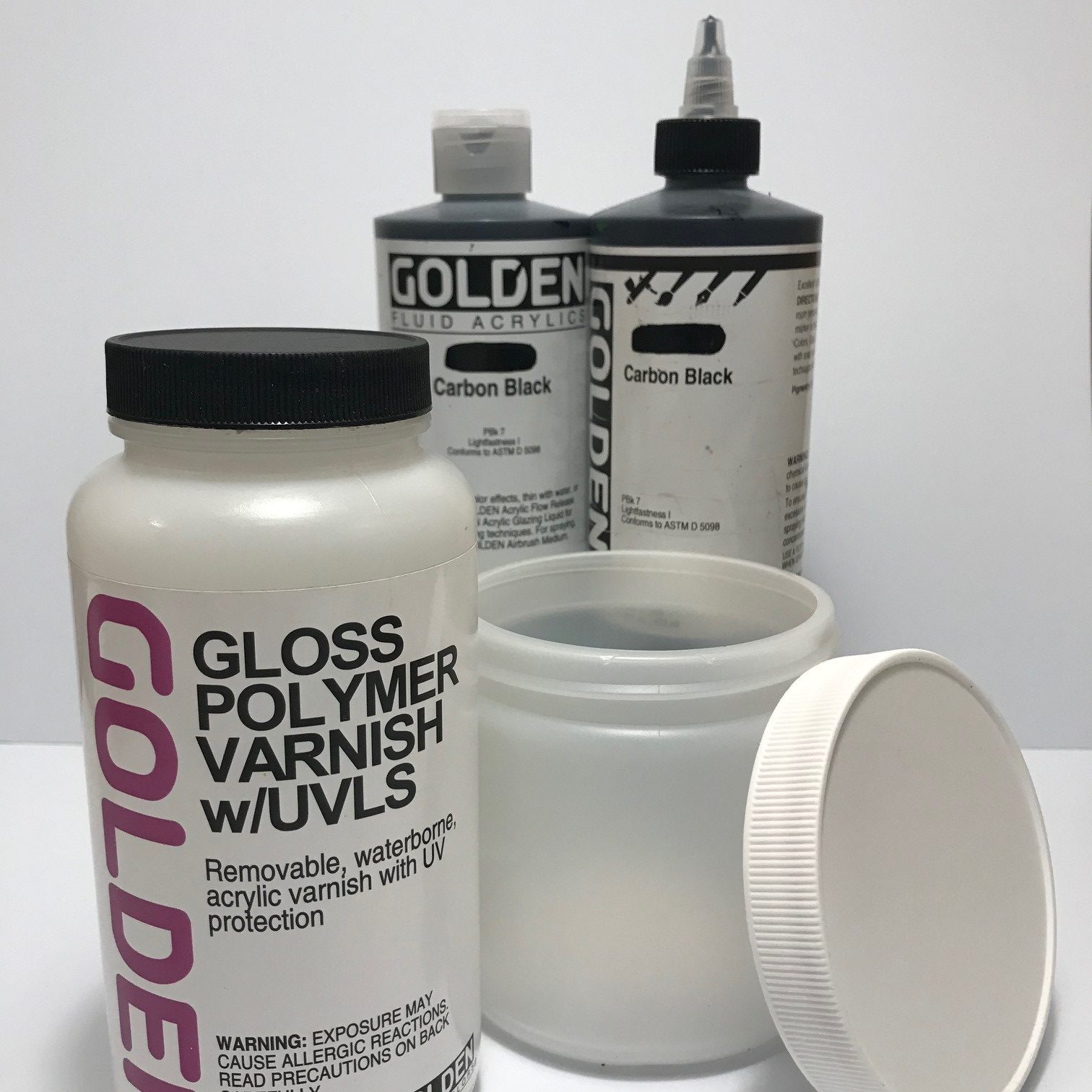Despite being discontinued, GOLDEN Stop-Out Varnish for Intaglio Printmaking has remained popular in many printmaking circles for being a non-toxic alternative to traditional asphaltum and lacquer-based stop-out varnishes. While we have no plans to bring this product back into our lineup, we wanted to share a simple recipe for interested printmakers and artists who want to make their own Stop-Out Varnish for Intaglio Printmaking using GOLDEN products.
The Recipe
To get started, you will need water-borne GOLDEN Gloss Polymer Varnish w/UVLS and either Fluid or High Flow acrylic Carbon Black. GOLDEN Polymer Varnish could work on its own as a removable Stop-Out Varnish, but since Polymer Varnish is transparent, small additions of 1-10% Carbon Black will add a nice contrast to the varnish. It is important to keep additions of Carbon Black within this threshold, as larger additions of color will make it more difficult or impossible to remove. This mixture can be used with all intaglio metal plate etching where ferric chloride or Edinburgh Etch is used.
Application Instructions
Prior to use, we recommend first degreasing the etching plate using a paste created from a mixture of Calcium Carbonate (aka Chalk or Whiting) and water. Gently rub the surface of the plate with the paste using a lint free cloth. Household vinegar may also be used to create the paste or as a final rinse over the surface of the plate after the rubbing has taken place. Make sure the plate is thoroughly rinsed afterwards. Once the plate has been degreased the Stop-Out Varnish mixture can be brush applied or poured undiluted over the plate. If spray applications are desired, we recommend thinning the Stop-Out Varnish mixture with water in a 2:1 ratio, (2 parts Stop-Out mixture to 1 part water).
After each etch and prior to any reapplication of the Stop-Out Varnish, it is important to thoroughly rinse the plate with cool water. Rinsing with a water solution containing 5% Washing Soda (Sodium Carbonate) can also be used to aid in neutralizing any remaining acid that may have accumulated in textured areas resulting from the etching process. Make sure there is no remaining acid, washing soda, or water present on the plate prior to re-application of the Stop-Out Varnish as this can lead to adhesion failure whilst etching.
Removal
Once the etching is complete, removal is possible by soaking the plate in a photo developing tray consisting of 1 quart hot water and 1 half cup Washing Soda. Using a soft brush gently work the surface of the plate until the varnish dissolves. For plates where the varnish has remained for more than a few days or plates where the varnish is being stubborn and not removing with washing soda, create a bath solution consisting of cold water and 10% household ammonia using the same process described above.
For those who have experience with GOLDEN Stop-Out Varnish for Intaglio Printmaking, this mixture will be slightly softer once it dries, so scribing through the acrylic is not recommended and testing is encouraged for each application.
If you have any questions or comments about this article or any other paint related topic, please feel free to contact our Materials Application Department at [email protected] or by calling 800-959-6543.
About Scott Fischer
View all posts by Scott Fischer -->Subscribe
Subscribe to the newsletter today!
No related Post


A Question:
Does this also work with a nitric acid etching process – I work on zinc plates.
Hello Steve, Thank you for your question. The Stop-Out recipe is designed to work with Ferric Chloride. Nitric acid would be too strong and would likely cause the acrylic to break down. Hopefully this helps if you have more questions feel free to email us at [email protected]
Can you make a batch of this up and keep it for use? If so, how long will it keep for?
Thanks!
Hello Ailsa,
You could certainly make a mixture of this and it should keep a long time as long as the container is properly sealed and stored in normal room conditions. We recommend making the mix with the concentrated Polymer Varnish and the Carbon Black and diluting this for each use and not storing long term the diluted mixture. If you did need to store a diluted mixture in the short term, we would recommend using distilled water to avoid potential for microbial growth that can develop from tap water. We hope this answers your question, let us know if you have more for us!
Best Regards,
Scott
Hi I am in Australia
I could find these two products and not sure if they are the same as mentioned above.
Golden Polymer Varnish with UVLS (Gloss) 236ml CODE:GAC7710-5
SKU:738797921191
Golden Fluid Acrylics 118ml – Carbon Black S1CODE:GAC2040-4
SKU:738797204041
Thank you
Hello Anne,
Yes these are the correct products and codes for creating a Stop-Out Varnish for printmaking. The Gloss Polymer Varnish 7710 and the Fluid Carbon Black 2040. We hope this helps and let us know if have more questions!
Best,
Scott